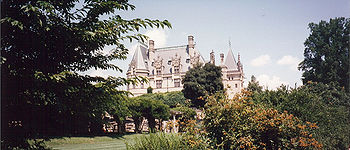Biltmore Estate
Biltmore Estate | |
 Biltmore house | |
| Location | Asheville, North Carolina |
|---|---|
| Built | 1888-95 |
| Architect | Richard Morris Hunt; Frederick Law Olmsted |
| Architectural style | Renaissance, Other |
| NRHP reference No. | 66000586 [1] |
| Added to NRHP | October 15, 1966 |
Biltmore House is a French Renaissance-inspired chateau near Asheville, North Carolina, built by George Washington Vanderbilt II between 1888 and 1895. It is the largest privately-owned home in the United States, at 175,000 square feet. Still owned by Vanderbilt's descendants, it stands today as one of the most prominent remaining examples of the Gilded Age.
History
In the 1880s, at the height of the Gilded Age, George Washington Vanderbilt II, youngest son of William Henry Vanderbilt, began to make regular visits with his mother to the Asheville area. He loved the scenery and climate so much that he decided to create his own winter estate in the area, as his older brothers and sisters had built opulent summer houses in places such as Newport, Rhode Island and Hyde Park, New York.
Vanderbilt's idea was to replicate the working estates of Europe. He commissioned Richard Morris Hunt, who had previously designed houses for various family members, to design the house in imitation of several Loire Valley chateaux, including the Chateau de Blois. Wanting the best, Vanderbilt also employed Frederick Law Olmsted to design the grounds, including the deliberately rustic three-mile Approach Road, and Gifford Pinchot to manage the forests. Intending that the estate could be self-supporting, Vanderbilt set up scientific forestry programs, poultry farms, cattle farms, hog farms and a dairy. The estate included its own village (today Biltmore Village) and even a church. Family members and friends invited from all over the United States and beyond came to experience the opulent estate with the splendor of Olmsted's sweet-smelling gardens, rich foods at the 64-seat banquet table, and the stunning beauty of Vanderbilt's mountainous grounds. Famous guests through the years include author Edith Wharton, satirist Henry James, and Presidents McKinley, Wilson, Nixon, and George H.W. Bush.
Vanderbilt paid little attention to the family business or his own investments, and the construction and upkeep of Biltmore depleted much of his inheritance. After Vanderbilt died of complications from an emergency appendectomy in 1914, his widow, Edith Dresser Vanderbilt, finalized the sale of much of the original 125,000 acres (506 km²) to the federal government (begun by Vanderbilt before his death), which became the nucleus of Pisgah National Forest.
The estate today covers approximately 8,000 acres and is split in half by the French Broad River. It is owned by The Biltmore Company, which is controlled by Vanderbilt's great-grandson, William A.V. Cecil, II. In 1963, it was designated a National Historic Landmark.
Tourist attraction

In an attempt to bolster the depression-riven economy, Vanderbilt's only child, Cornelia Vanderbilt Cecil, and husband John Amherst Cecil opened Biltmore House to the public on March 15, 1930.
The house was occupied less and less permanently until 1956, when it was opened to the public as a house museum. Visitors from all over the world continue to be amazed at the 70,000 gallon indoor swimming pool, bowling alley, turn-of-the-century exercise equipment, two-story library, and other rooms filled with art works, furniture, and 19th-century novelties like elevators, forced-air heating, centrally-controlled clocks, fire alarms, and an intercom system. It remains a major tourist attraction in western North Carolina, with approximately 1,000,000 visitors each year.
In 2005 the fourth floor of the house was opened. The floor reveals the life of a Biltmore House maid with a Servants’ Hall, Servants’ Bedrooms and Bathrooms, and three house closets. The Architectural Model Room showcases Hunt’s 1889 model of Biltmore House, while the Observatory offers magnificent views of the estate from a central vantage point at the top of the main tower.
Future plans include the restoration of the Oak Sitting Room (Spring 2009) and Second Floor Living Hall (2012), as well as the opening of the Library Wing guest rooms.
Trivia
Biltmore Estate's grounds and buildings have appeared in a number of major motion pictures:
• The Clearing (2002)
• Hannibal (film) (2001)
• Patch Adams (1998)
• My Fellow Americans (1996)
• Richie Rich (1994)
• Forrest Gump (1993)
• Last of the Mohicans (1991)
• Mr. Destiny (1990)
• The Private Eyes (1981 film) (1980)
• Being There (1979)
• The Swan (1956)
• Tap Roots (1948)
The Biltmore Estate ranked 8th in a 2007 poll by the American Institute of Architects of the top 150 favorite structures in the United States.
References
- ^ "National Register Information System". National Register of Historic Places. National Park Service. 2006-03-15.
External links
- Biltmore Estate official website
- Landmark designation
- Biltmore, a Legacy in Stone with photos
- Christmas in Biltmore with photos
Template:Geolinks-US-streetscale
la la biltmore sucks
-
Caption1
-
Caption2
-
Caption1
-
Caption2
-
Caption1
-
Caption2
-
Caption1
-
Caption2
- 1895 architecture
- Houses in North Carolina
- Castles in the United States
- Châteaux
- Vanderbilt family
- National Historic Landmarks of the United States
- Registered Historic Places in North Carolina
- Asheville, North Carolina
- Buncombe County, North Carolina
- Richard Morris Hunt buildings
- Museums in North Carolina
- Historic houses


